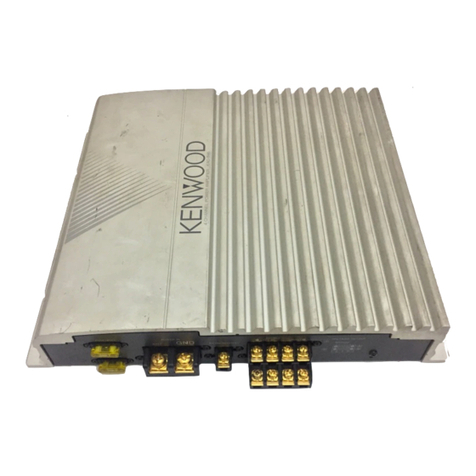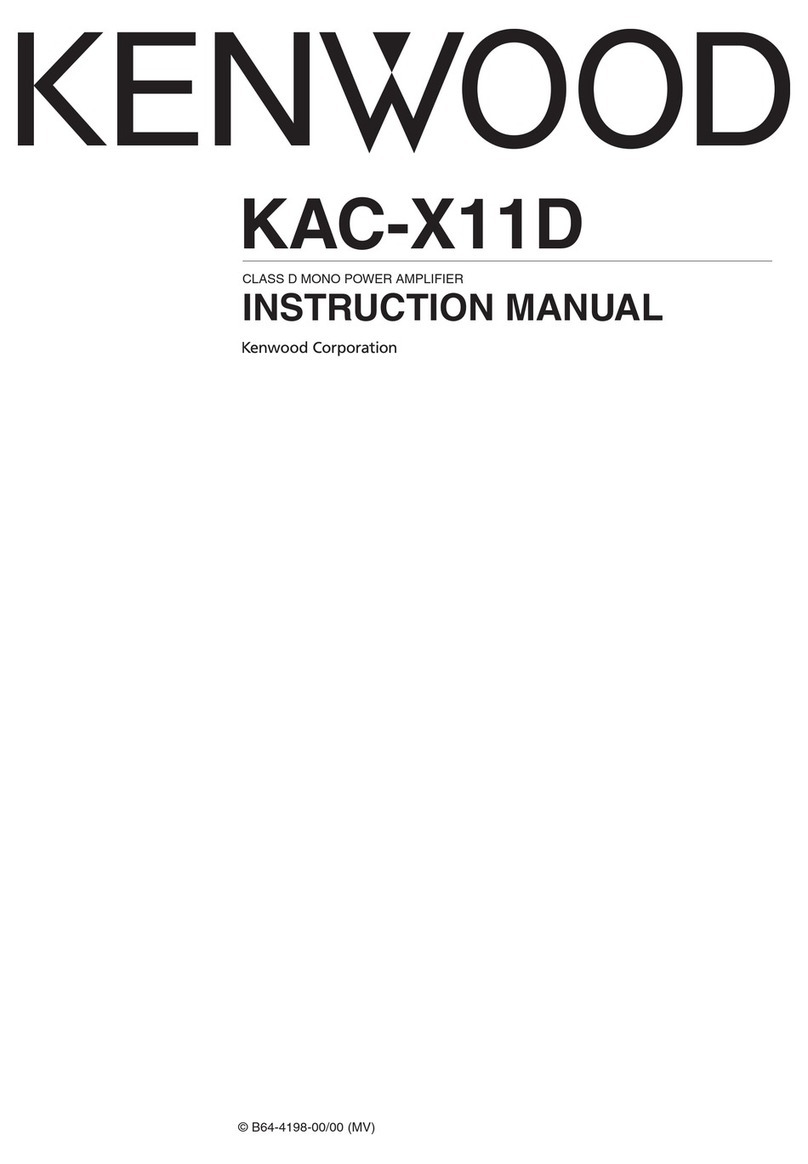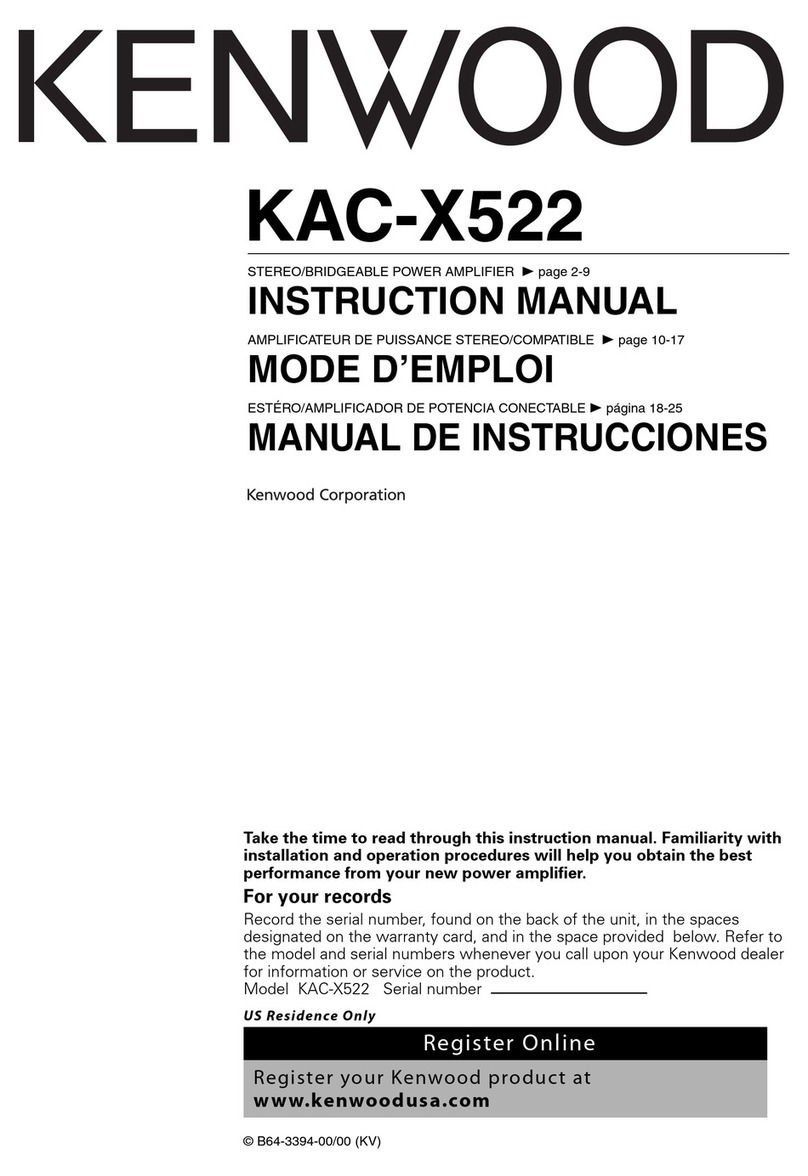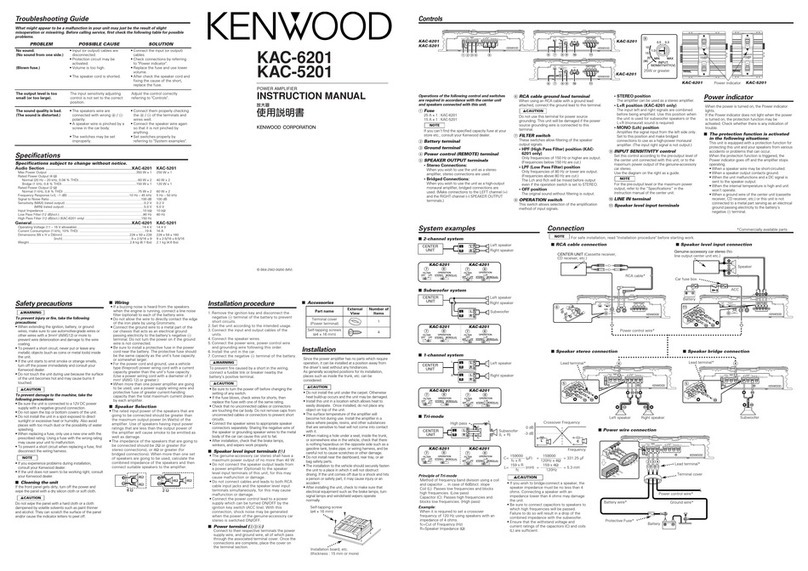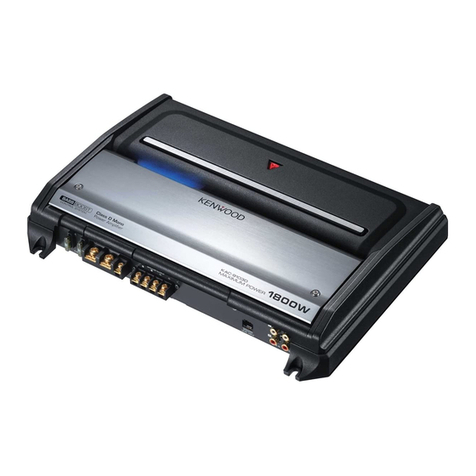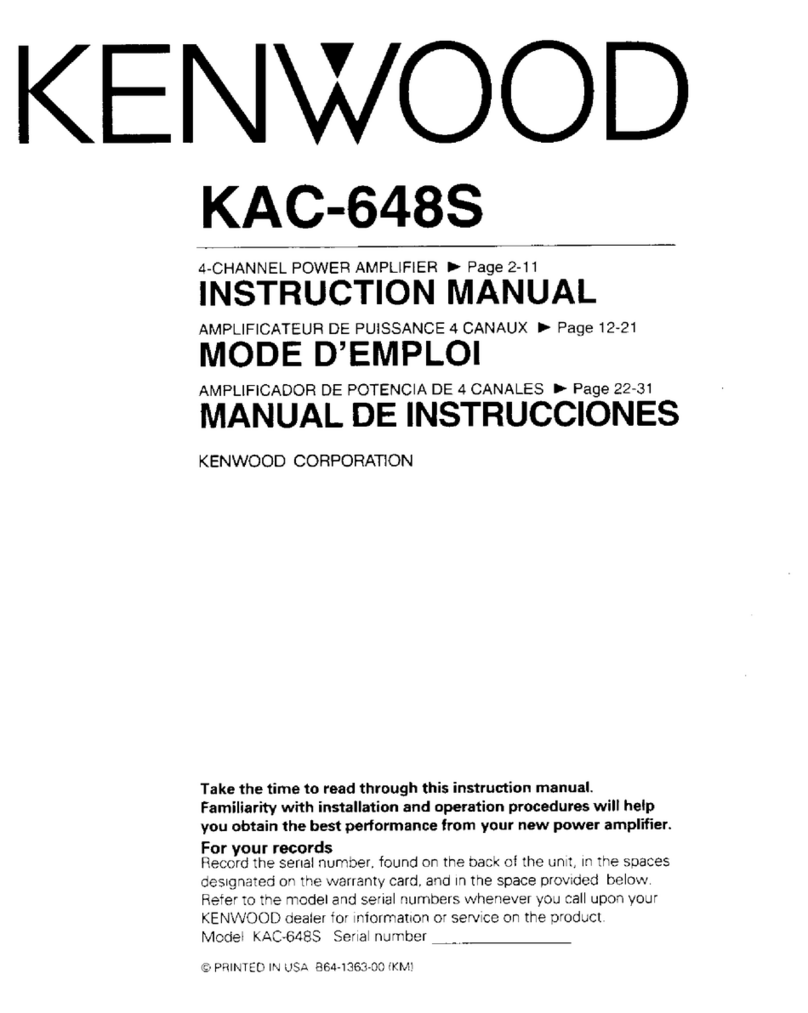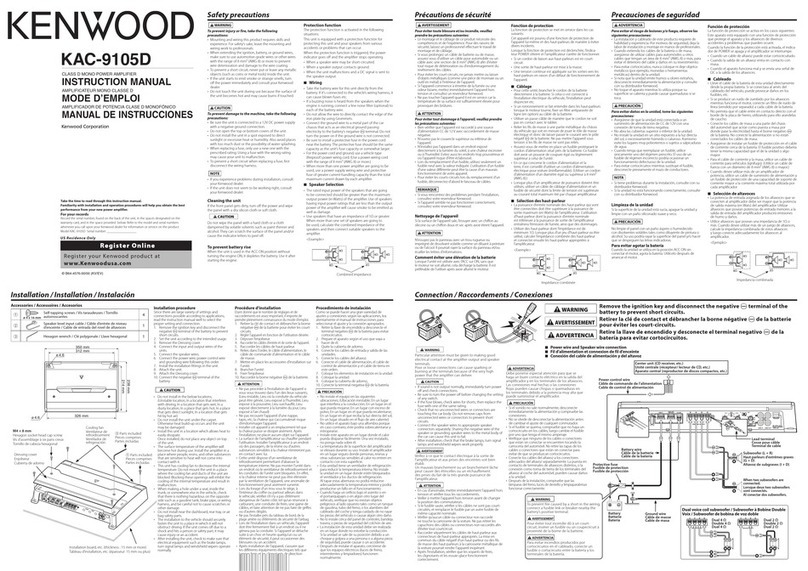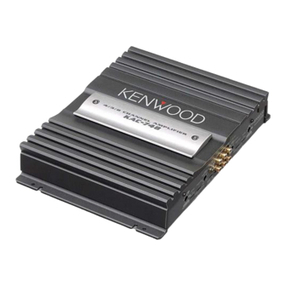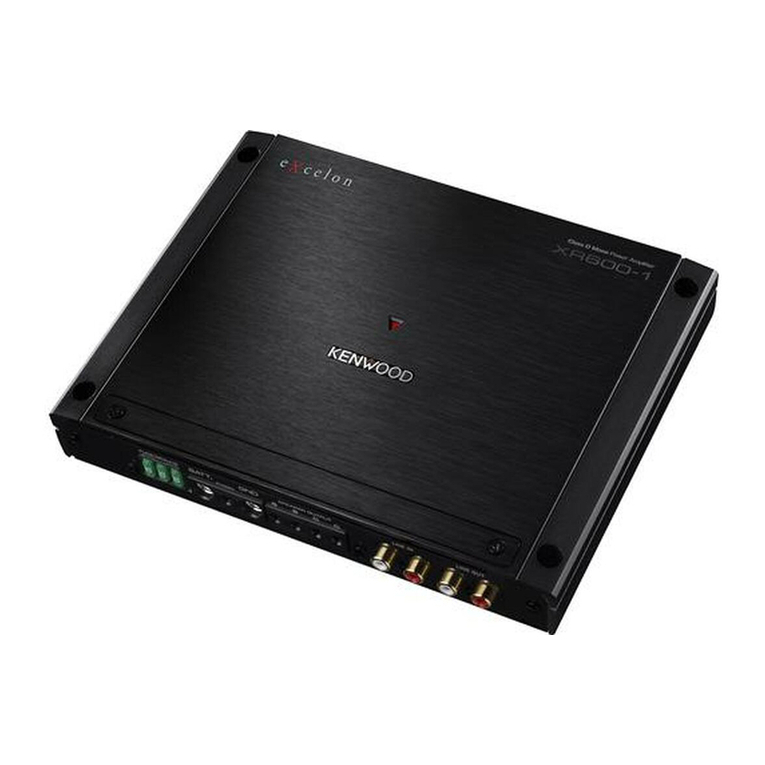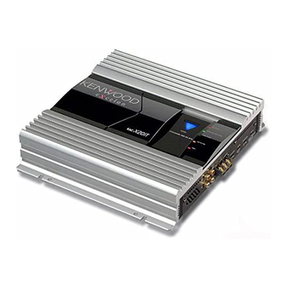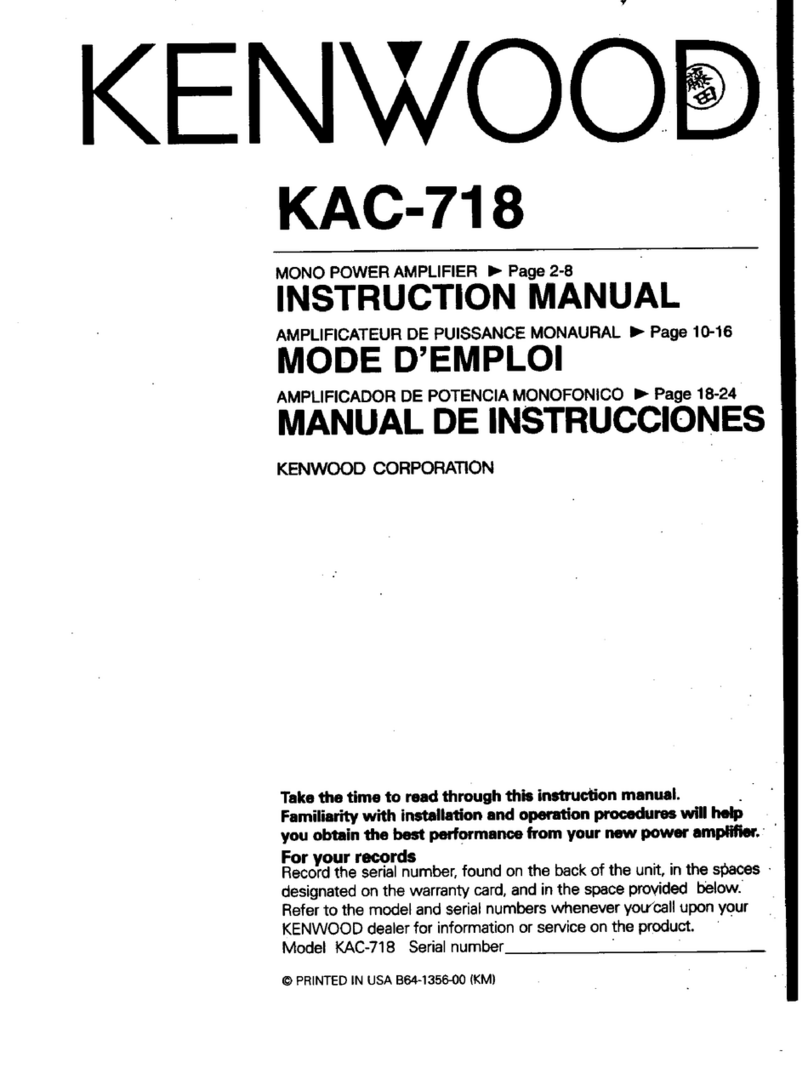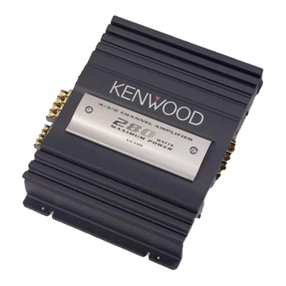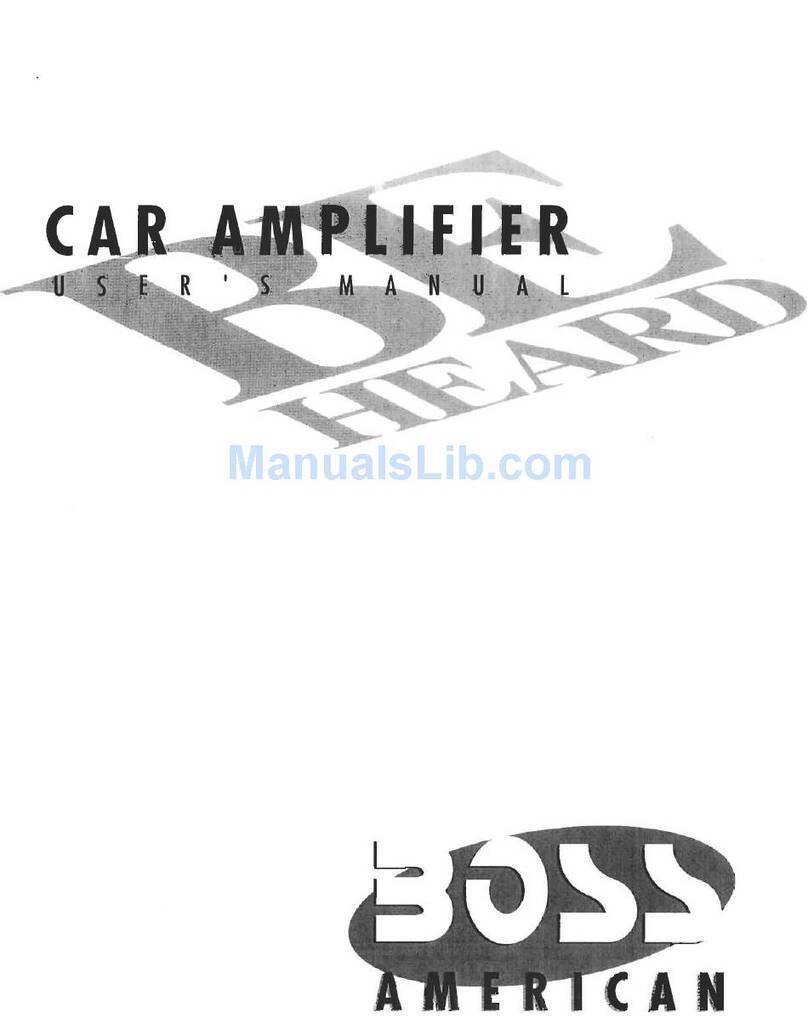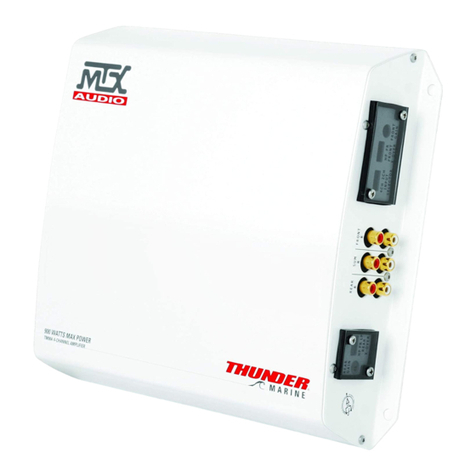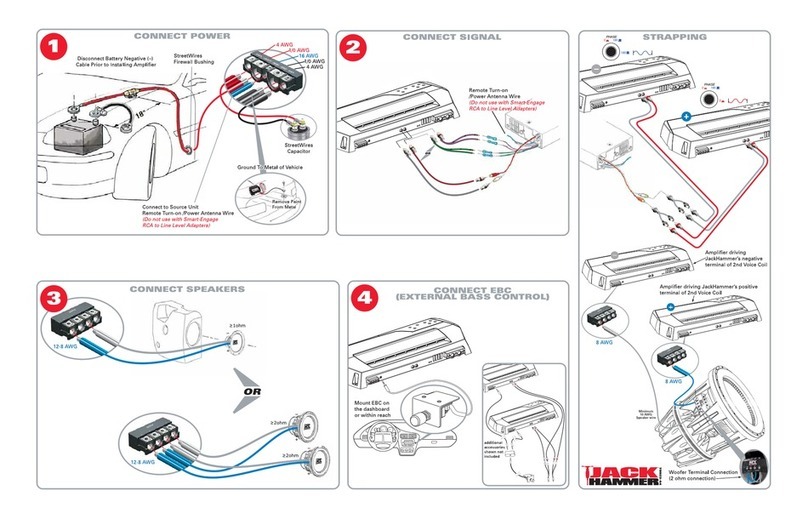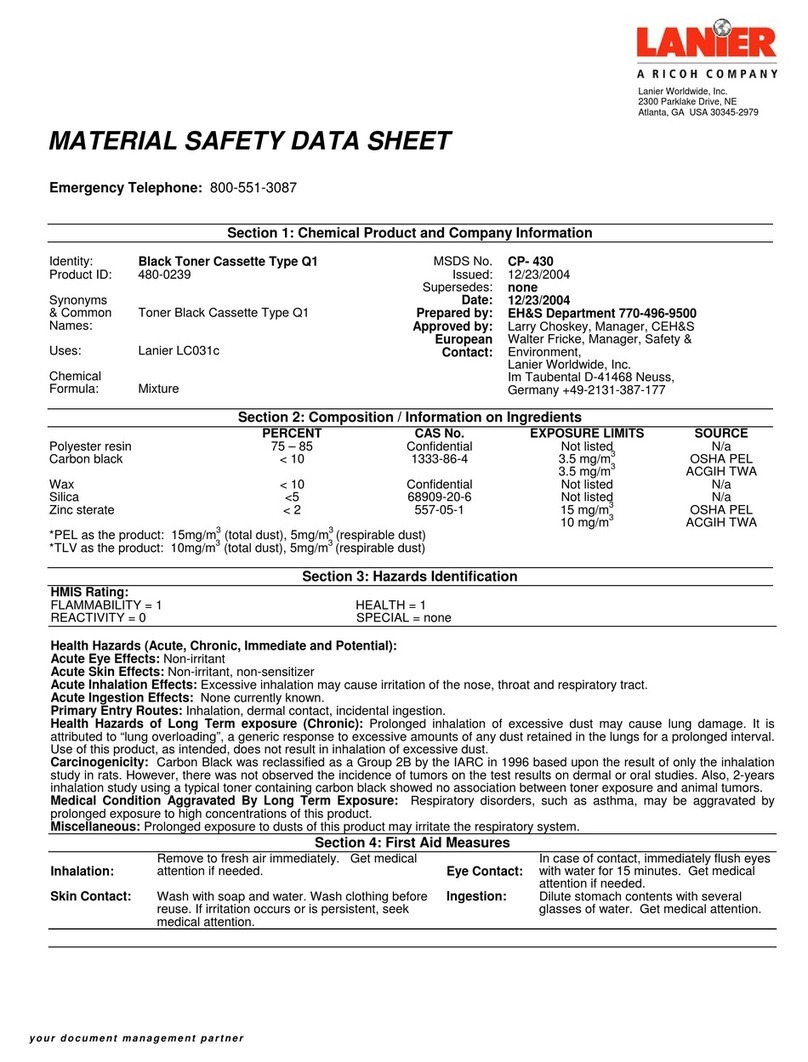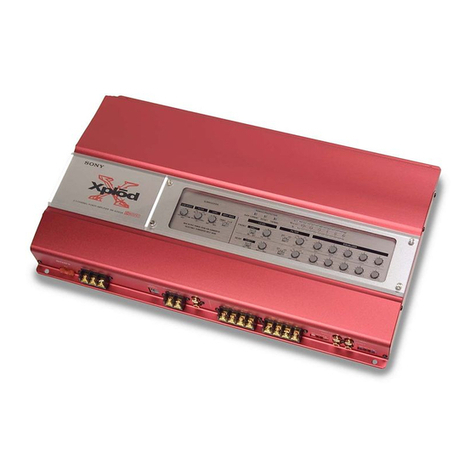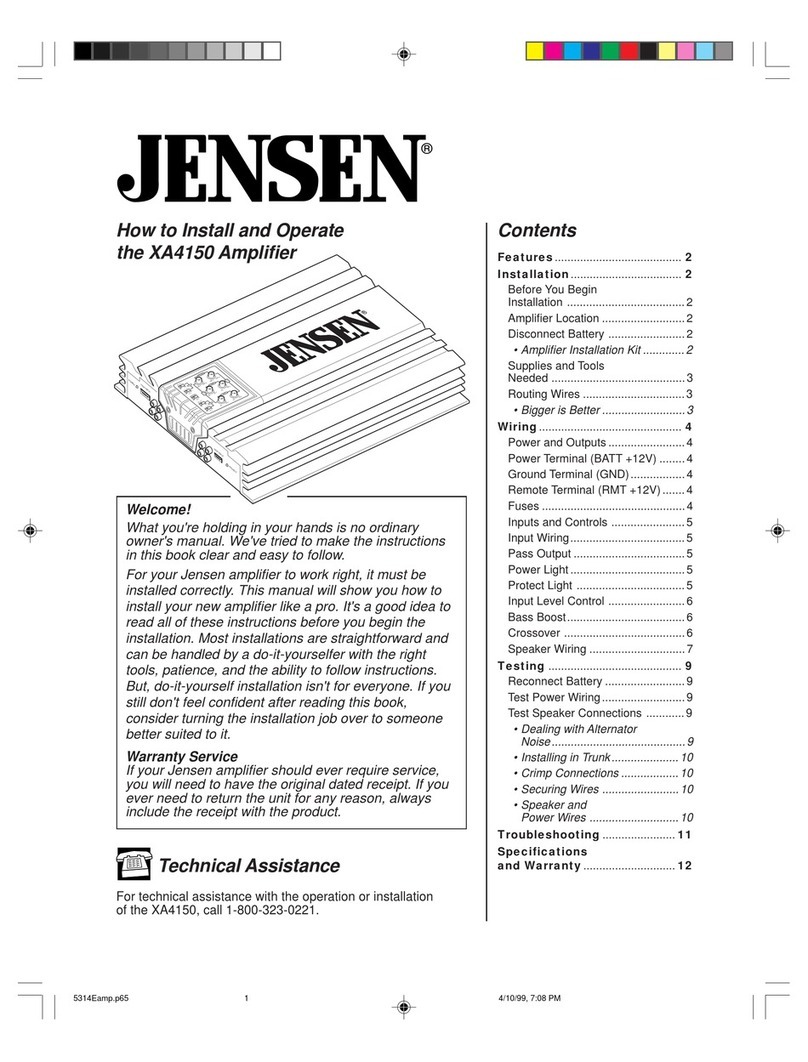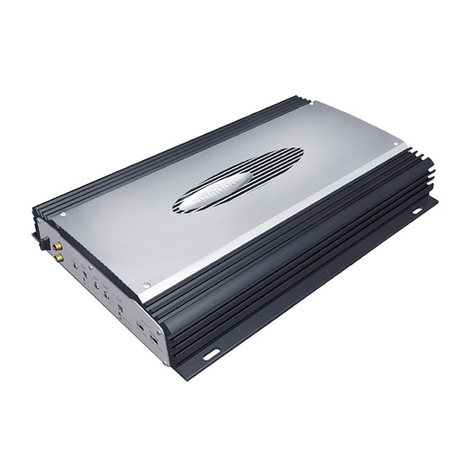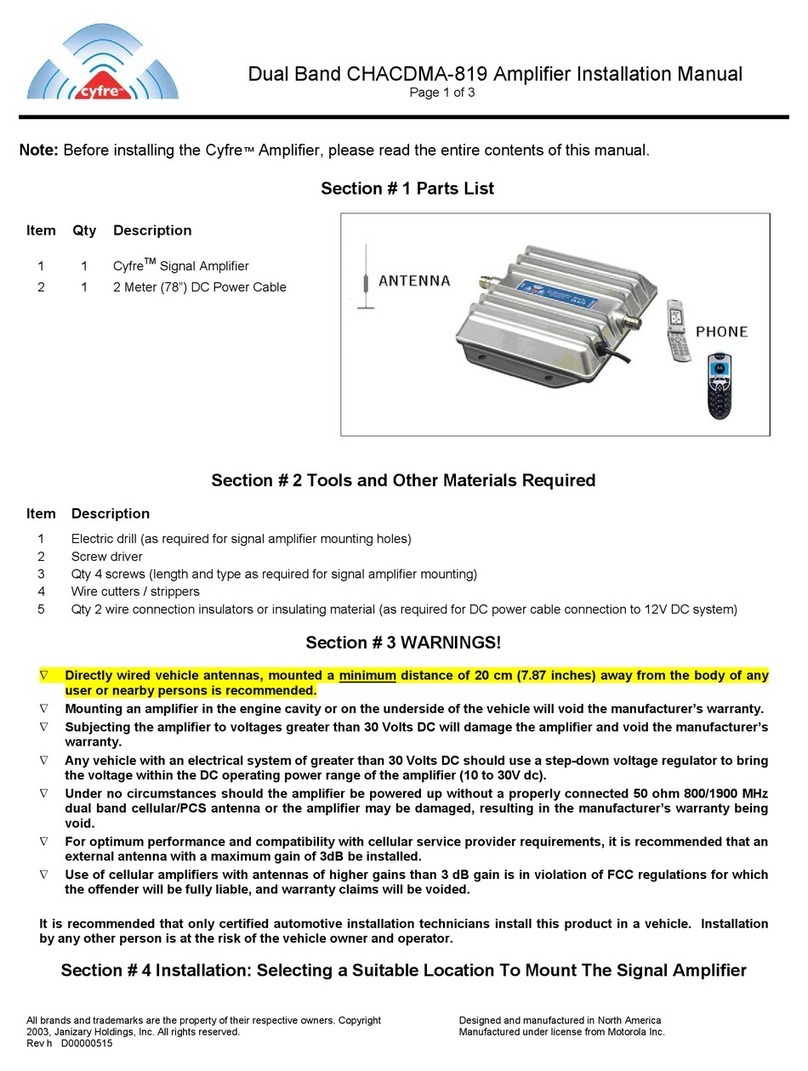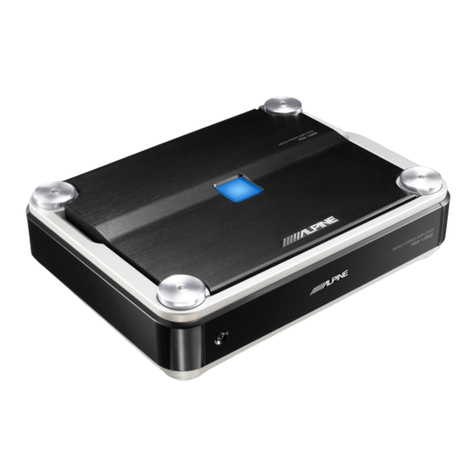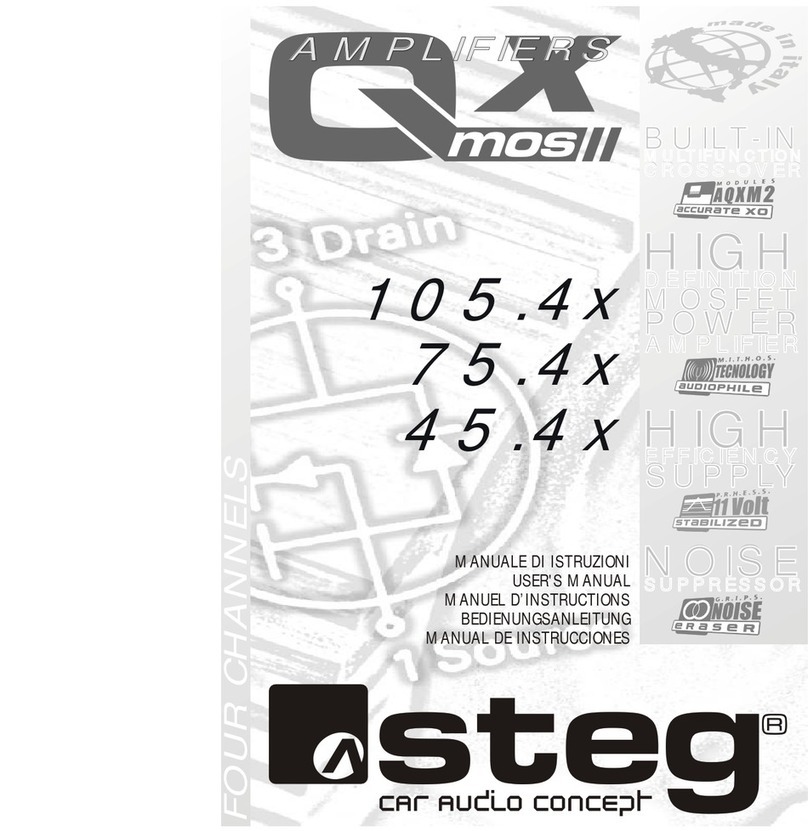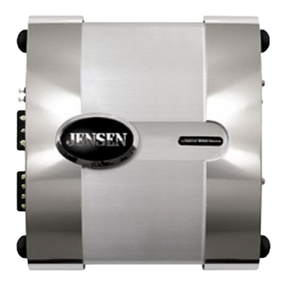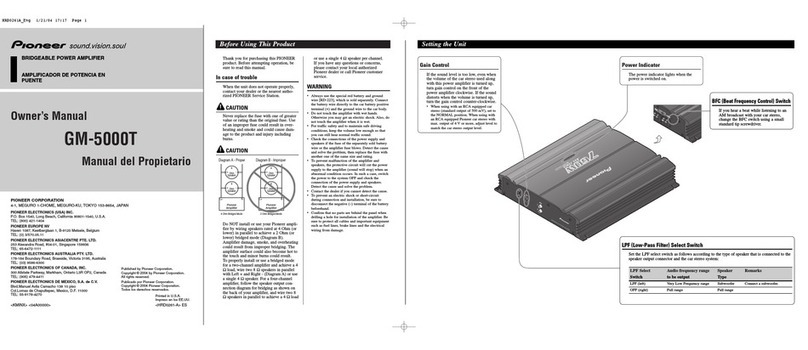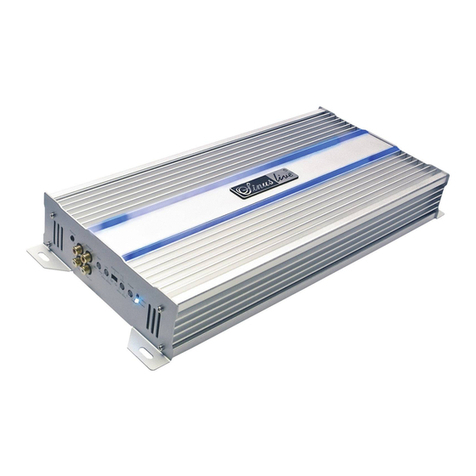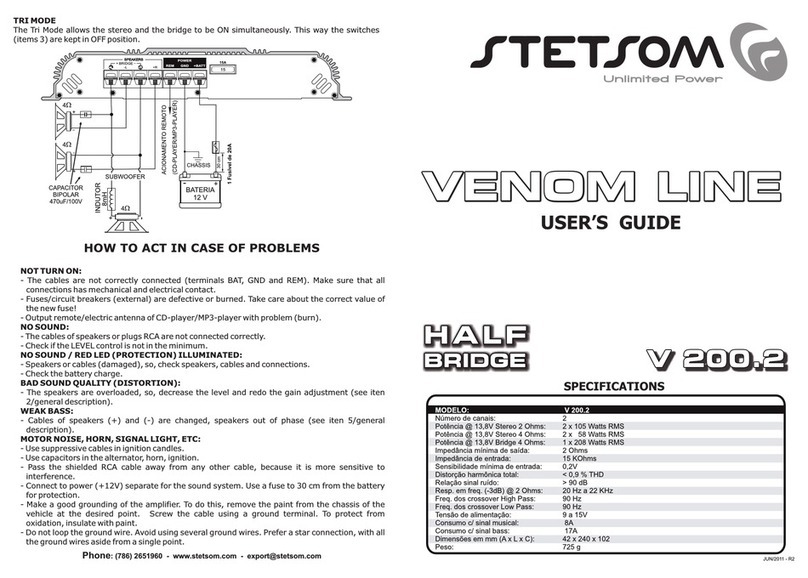
L
C
C
L
C
C
!@#
L
R
L
R
L
R
L
R
A
B
LPF
HPF
OFF
B.CH FILTERA.CH FILTER
B.CH OPERATION
INPUT SELECTOR
MONO (Lch)
STEREO
A.CH OPERATION
MONO (Lch)
STEREO
LPF
HPF
OFF
A AB
25
25
4
4
LL
A
A
L
A
A
B
R
B
R
LR
RL
R
AR
B
B
L
A
R
L
R
B
L
B
LEFT
BRIDGED
RIGHT
A
B
BRIDGED
RL
LEFT
BRIDGED
RIGHT
A
B
BRIDGED
RL
7
55
GND
L
R
L
R
A
B
A
B
L
R
L
R
A
B
L
R
L
R
A
B
L
R
L
R
A
B
L
R
L
R
A
B
L
R
L
R
A
B
L
R
L
R
!
@
#
F
R
LPF
HPF
OFF
B.CH FILTERA.CH FILTER
LPF
HPF
OFF
@
LPF
HPF
OFF
B.CH FILTERA.CH FILTER
LPF
HPF
OFF
@
LPF
HPF
OFF
B.CH FILTERA.CH FILTER
LPF
HPF
OFF
B.CH OPERATION INPUT SELECTOR
MONO (Lch)
STEREO
A.CH OPERATION
MONO (Lch)
STEREO
A AB
!#
B.CH OPERATION INPUT SELECTOR
MONO (Lch)
STEREO
A.CH OPERATION
MONO (Lch)
STEREO
A AB
!#
B.CH OPERATION INPUT SELECTOR
MONO (Lch)
STEREO
A.CH OPERATION
MONO (Lch)
STEREO
A AB
!#
B.CH OPERATION INPUT SELECTOR
MONO (Lch)
STEREO
A.CH OPERATION
MONO (Lch)
STEREO
A AB
System examples
Installation procedure
1. Remove the ignition key and disconnect the
negative -terminal of the battery to prevent
short circuits.
2. Set the unit according to the intended usage.
3. Connect the input and output cables of the
units.
4. Connect the speaker wires.
5. Connect the power wire, power control wire
and grounding wire following this order.
6. Install the unit in the car.
7. Connect the negative -terminal of the battery.
To prevent fire caused by a short in the wiring,
connect a fusible link or breaker nearby the
battery’s positive terminal.
•Be sure to turn the power off before changing the
setting of any switch.
•If the fuse blows, check wires for shorts, then
replace the fuse with one of the same rating.
•Check that no unconnected cables or connectors
are touching the car body. Do not remove caps from
unconnected cables or connectors to prevent short
circuits.
•Connect the speaker wires to appropriate speaker
connectors separately. Sharing the negative wire of
the speaker or grounding speaker wires to the metal
body of the car can cause this unit to fail.
•After installation, check that the brake lamps,
winkers, and wipers work properly.
■Speaker level input terminals (0)
•The genuine-accessory car stereo shall have a
maximum power output of no more than 40 W.
•Do not connect the speaker output leads from
a power amplifier (Optional) to the speaker
level input terminals of this unit, for this may
cause malfunction or damage.
•Do not connect cables and leads to both RCA
cable input jacks and the speaker level input
terminals simultaneously, for this may cause
malfunction or damage.
•Connect the power control lead to a power
supply which can be turned ON/OFF by the
ignition key switch (ACC line). With this
connection, shock noise may be generated
when the power of the genuine-accessory car
stereo is switched ON/OFF.
■Power terminal (234)
Connect to their respective terminals the power
supply wire, and ground wire, all of which pass
through the associated terminal cover. Once the
connections are complete, place the cover on
the terminal section.
■Accessories
Installation
Since the power amplifier has no parts which require
operation, it can be installed at a position away from
the driver’s seat without any hindrances.
As generally accepted positions for its installation,
places such as inside the trunk, etc. can be
considered.
•Do not install the unit under the carpet. Otherwise
heat build-up occurs and the unit may be damaged.
•Install this unit in a location which allows heat to
easily dissipate. Once installed, do not place any
object on top of the unit.
•The surface temperature of the amplifier will
become hot during use. Install the amplifier in a
place where people, resins, and other substances
that are sensitive to heat will not come into contact
with it.
•When making a hole under a seat, inside the trunk,
or somewhere else in the vehicle, check that there
is nothing hazardous on the opposite side such as a
gasoline tank, brake pipe, or wiring harness, and be
careful not to cause scratches or other damage.
•Do not install near the dashboard, rear tray, or air
bag safety parts.
•The installation to the vehicle should securely fasten
the unit to a place in which it will not obstruct
driving. If the unit comes off due to a shock and hits
a person or safety part, it may cause injury or an
accident.
•After installing the unit, check to make sure that
electrical equipment such as the brake lamps, turn
signal lamps and windshield wipers operate
normally.
2CAUTION
2CAUTION
2WARNING
KAC-6401
4-CHANNEL POWER AMPLIFIER
INSTRUCTION MANUAL
© B64-2568-00/00 (MV)
Specifications
Specifications subject to change without notice.
Audio Section
Max Power Output....................................................................................................................160 W ×2
Rated Power Output (4 Ω)
4 Channel Mode (20 Hz – 20 kHz, less than 0.08 % THD) .......................................................30 W ×4
3 Channel Mode (20 Hz – 20 kHz, 0.08 % THD) + (1 kHz, 0.8 % THD) ................30 W ×2 + 80 W ×1
2 Channel Mode (1 kHz, 0.8 % THD) .......................................................................................80 W ×2
Rated Power Output (2 Ω)
4 Channel Mode (1 kHz, 0.8 % THD) .......................................................................................40 W ×4
Frequency Response (+0, –3 dB) ........................................................................................5 Hz – 50 kHz
Signal to Noise Ratio ......................................................................................................................100 dB
Sensitivity (MAX) (rated output).........................................................................................................0.2 V
Sensitivity (MIN) (rated output)..........................................................................................................5.0 V
Input Impedance ..............................................................................................................................10 kΩ
Low Pass Filter Frequency (12 dB/oct.)............................................................................................80 Hz
High Pass Filter Frequency (12 dB/oct.) .........................................................................................150 Hz
General
Operating Voltage (11 – 16 V allowable)..........................................................................................14.4 V
Current Consumption (1 kHz, 10 % THD) ..........................................................................................18 A
Dimensions (W ×H ×D).............................................................................................268 ×59 ×220 mm
Weight................................................................................................................................2.9 kg (6.4 lbs)
Safety precautions
To prevent injury or fire, take the following
precautions:
•When extending the ignition, battery, or ground
wires, make sure to use automotive-grade wires or
other wires with a 3mm2(AWG12) or more to
prevent wire deterioration and damage to the wire
coating.
•To prevent a short circuit, never put or leave any
metallic objects (such as coins or metal tools) inside
the unit.
•If the unit starts to emit smoke or strange smells,
turn off the power immediately and consult your
Kenwood dealer.
•Do not touch the unit during use because the surface
of the unit becomes hot and may cause burns if
touched.
To prevent damage to the machine, take the
following precautions:
•Be sure the unit is connected to a 12V DC power
supply with a negative ground connection.
•Do not open the top or bottom covers of the unit.
•Do not install the unit in a spot exposed to direct
sunlight or excessive heat or humidity. Also avoid
places with too much dust or the possibility of water
splashing.
•When replacing a fuse, only use a new one with the
prescribed rating. Using a fuse with the wrong rating
may cause your unit to malfunction.
•To prevent a short circuit when replacing a fuse, first
disconnect the wiring harness.
•If you experience problems during installation,
consult your Kenwood dealer.
•If the unit does not seem to be working right, consult
your Kenwood dealer.
■Cleaning the unit
If the front panel gets dirty, turn off the power and
wipe the panel with a dry silicon cloth or soft cloth.
Do not wipe the panel with a hard cloth or a cloth
dampened by volatile solvents such as paint thinner
and alcohol. They can scratch the surface of the panel
and/or cause the indicator letters to peel off.
■Wiring
•If a buzzing noise is heard from the speakers
when the engine is running, connect a line noise
filter (optional) to each of the battery wire.
•Do not allow the wire to directly contact the edge
of the iron plate by using Grommets.
•Connect the ground wire to a metal part of the
car chassis that acts as an electrical ground
passing electricity to the battery‘s negative -
terminal. Do not turn the power on if the ground
wire is not connected.
•Connect the power cable directly to the battery.
It can cause blown fuses if you connect to the
vehicle wring harness.
•Be sure to install a protective fuse in the power
cord near the battery. The protective fuse should
be the same capacity as the unit’s fuse capacity
or somewhat larger.
•For the power cord and ground, use a vehicle
type (fireproof) power wring cord with a current
capacity greater than the unit’s fuse capacity.
(Use a power wiring cord with a diameter of 3
mm2(AWG 12) or greater.)
•When more than one power amplifier are going
to be used, use a power supply wiring wire and
protective fuse of greater current-handling
capacity than the total maximum current drawn
by each amplifier.
■Speaker Selection
•The rated input power of the speakers that are
going to be connected should be greater than
the maximum output power (in Watts) of the
amplifier. Use of speakers having input power
ratings that are less than the output power of
the amplifier will cause smoke to be emitted as
well as damage.
•The impedance of the speakers that are going to
be connected should be 2Ωor greater (for
stereo connections), or 4Ωor greater (for
bridged connections). When more than one set
of speakers are going to be used, calculate the
combined impedance of the speakers and then
connect suitable speakers to the amplifier.
2CAUTION
NOTE
2CAUTION
2WARNING
This is a 4 channel amplifier including 2 stereo
amplifiers in a body. One amplifier is referred to as
amplifier A and the other is amplifier B. This unit is
compatible with a large variety of systems by
combining the switches and functions described
in the following.
1Fuse (25 A)
2Battery terminal
3Ground terminal
4Power control terminal
5Amplifier A/B SPEAKER OUTPUT
terminals
•Stereo Connections:
When you wish to use the unit as a stereo
amplifier, stereo connections are used.
•Bridged Connections:
When you wish to use the unit as a high-output
monaural amplifier, bridged connections are
used. (Make connections to the LEFT channel (+)
and the RIGHT channel (–) SPEAKER OUTPUT
terminals.)
6INPUT SENSITIVITY control
Set this control according to the pre-output level of
the center unit connected with this unit, or to the
maximum power output of the genuine-accessory
car stereo.
The sensitivities of amplifiers A and B can be
adjusted independently regardless of the position
of the input selector switch.
Use the diagram on the right as a guide.
For the pre-output level or the maximum power
output, refer to the “Specifications” in the
instruction manual of the center unit.
7RCA cable ground lead terminal
When using an RCA cable with a ground lead
attached, connect the ground lead to this terminal.
Do not use this terminal for power source
grounding. This unit will be damaged if the power
source grounding wire is connected to this
terminal.
8Amplifier A/B LINE IN terminals
9LINE OUT terminal
These jacks output respectively the signals input to
amplifiers A and B. They always output the stereo
signals regardless of the position of the
OPERATION switch.
0Speaker level input terminals
!OPERATION switch
The amplification methods of the signals input to
amplifiers A and B can be selected independently
according to the setting of this switch.
•STEREO position:
The amplifier can be used as a stereo amplifier.
•MONO (Lch) position:
Amplifies the signal input from the left side only.
Set to this position and make bridged
connections to use as a high-power monaural
amplifier. (The input right signal is not output.)
@FILTER switch
These switches allow filtering of the speaker
output signals.
•HPF (High Pass Filter) position
Only frequencies of 150 Hz or higher are output.
(Frequencies below 150 Hz are cut.)
•LPF (Low Pass Filter) position
Only frequencies of 80 Hz or lower are output.
(Frequencies above 80 Hz are cut.)
The Lch and Rch will be mixed before output
even if the operation switch is set to STEREO.
•OFF position
The original sound without filtering is output.
#INPUT SELECTOR switch
This switch selects the input method of the signals
to be amplified by amplifiers A and B.
•AB position:
Amplifies both of the signals input to amplifiers A
and B.
•Aposition:
Amplifies only signal input amplifier A with both
amplifiers A and B.
Power indicator
When the power is turned on, the Power indicator
lights.
If the Power indicator does not light when the power
is turned on, the protection function may be
activated. Check whether there is any indication of
trouble.
■The protection function is activated
in the following situations:
This unit is equipped with a protection function for
protecting this unit and your speakers from various
accidents or problems that can occur.
When the protection function is triggered, the
Power indicator goes off and the amplifier stops
operating.
•When a speaker wire may be short-circuited.
•When a speaker output contacts ground.
•When the unit malfunctions and a DC signal is
sent to the speaker output.
•When the internal temperature is high and unit
won’t operate.
•When a ground wire of the center unit (cassette
receiver, CD receiver, etc.) or this unit is not
connected to a metal part serving as an electrical
ground passing electricity to the battery's
negative -terminal.
2CAUTION
NOTE
Controls
Terminal cover
Battery
Ground wire*
Battery wire*
Protective Fuse*
Power control wire*
■Power wire connection
Connection
For safe installation, read "Installation procedure" before starting work.
NOTE
CENTER UNIT (Cassette receiver,
CD receiver, etc.)
Power control wire*
RCA cable*
Genuine-accessory
car stereo (No line
output center unit
etc.)
ACC
Battery
Car fuse box
Lead terminal* Lead terminal*
■4-channel ■4-channel
■3-channel
■2-channel
■2ch + woofer
■2-channel
■RCA cable connection ■Speaker level input connection
■Speaker stereo connection ■Speaker bridge connection
CENTER
UNIT
CENTER
UNIT
CENTER
UNIT
■2-channel
CENTER
UNIT
■Tri-mode
Principle of Tri-mode
Method of frequency band division using a coil
and capacitor ... in case of 6dB/oct. slope
Coil (L): Passes low frequencies and blocks
high frequencies. (Low pass)
Capacitor (C): Passes high frequencies and
blocks low frequencies. (High pass)
Example:
When it is required to set a crossover
frequency of 120 Hz using speakers with an
impedance of 4 ohms.
fc=Cut of Frequency (Hz)
R=Speaker Impedance (Ω)
•If you wish to bridge-connect a speaker, the
speaker impedance must be no less than 4
ohms. Connecting a speaker with an
impedance lower than 4 ohms may damage
the unit.
•Be sure to connect capacitors to speakers to
which high frequencies will be passed.
Failure to do so will result in a drop of the
combined impedance with the subwoofer.
•Ensure that the withstand voltage and
current ratings of the capacitors (C) and coils
(L) are sufficient.
2CAUTION
0 dB
-3 dB
Crossover Frequency
Frequency
CENTER
UNIT
High pass
Subwoofer
(L + R)
159000
C= (µF)
fc x R
159 x R
L= (mH)
fc
159000
= = 331.25 µF
120Hz x 4Ω
159 x 4Ω
= = 5.3 mH
120Hz
Front left speaker
Front right speaker
Rear left speaker
Rear right speaker
Left speaker
Right speaker
Left speaker
Right speaker
Subwoofer
PROBLEM POSSIBLE CAUSE SOLUTION
No sound.
(No sound from one side.)
(Blown fuse.)
The output level is too
small (or too large).
The sound quality is bad.
(The sound is distorted.)
•Input (or output) cables are
disconnected.
•Protection circuit may be
activated.
•Volume is too high.
•The speaker cord is shorted.
The input sensitivity adjusting
control is not set to the correct
position.
•The speakers wire are
connected with wrong +/ -
polarity.
•Aspeaker wire is pinched by a
screw in the car body.
•The switches may be set
improperly.
•Connect the input (or output)
cables.
•Check connections by referring
to "Power indicator".
•Replace the fuse and use lower
volume.
•After check the speaker cord and
fixing the cause of the short,
replace the fuse.
Adjust the control correctly
referring to "Controls".
•Connect them properly checking
the +/ -of the terminals and
wires well.
•Connect the speaker wire again
so that it is not pinched by
anything.
•Set switches properly by
referring to "System examples".
Lead terminal*
Troubleshooting Guide
What might appear to be a malfunction in your unit may just be the result of slight misoperation or
miswiring. Before calling service, first check the following table for possible problems.
Bridge
Bridge
White
White/Black
Gray
Gray/Black
Green
Green/Black
Purple
Purple/Black
A-channel
A.ch Left
A.ch Right
B-channel
B.ch Left
B.ch Right
Front
Rear
Cable Color of the
connector
F
R
*Commercially available
parts
Part name Number of
Items
External
View
Terminal cover
(Power terminal) 1
Self-tapping screws
(ø4 ×16 mm) 4
Speaker level input
cable 1
Description of markings in the figure.
6
0.2(MAX)
(MIN)5
0.3
0.5
1
2
3
4
INPUT SENSITIVITY(V)
25
1 92 3 4 75 0
! #
8
@
6
(W)
30
40
20
10
Power indicator
Installation board, etc.
(thickness : 15 mm or more)
Self-tapping screw
(ø4 ×16 mm)
KAC-6401(M)1En 02.10.7 4:47 PM Page 1

